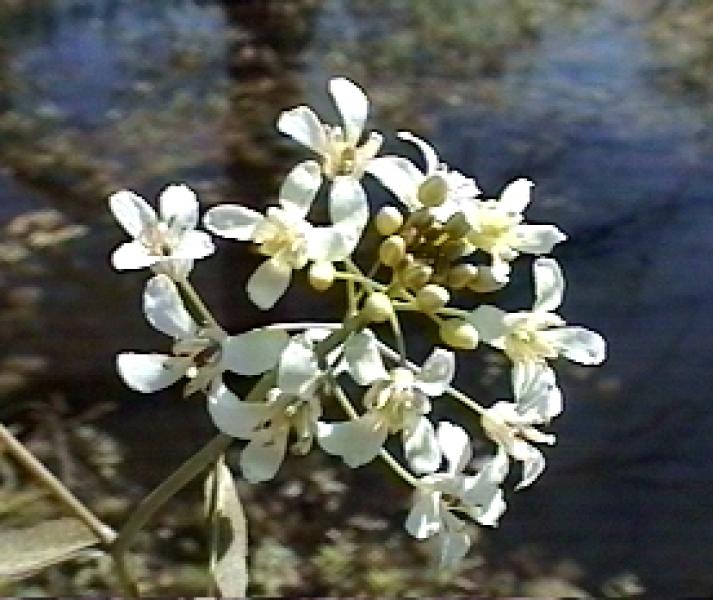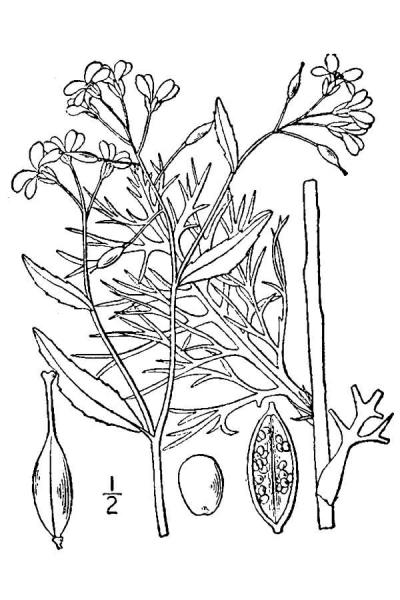Lake Water Cress
Rorippa aquatica (Eat.) Palmer & Steyermark
- Class
- Dicotyledoneae (Dicots)
- Family
- Brassicaceae (Mustard Family)
- State Protection
- Threatened
Listed as Threatened by New York State: likely to become Endangered in the foreseeable future. For animals, taking, importation, transportation, or possession is prohibited, except under license or permit. For plants, removal or damage without the consent of the landowner is prohibited.
- Federal Protection
- Not Listed
- State Conservation Status Rank
- S2
Imperiled in New York - Very vulnerable to disappearing from New York due to rarity or other factors; typically 6 to 20 populations or locations in New York, very few individuals, very restricted range, few remaining acres (or miles of stream), and/or steep declines.
- Global Conservation Status Rank
- G4?
Apparently Secure globally (most likely) - Conservation status is uncertain, but most likely uncommon in the world but not rare; usually widespread, but may be rare in some parts of its range; possibly some cause for long-term concern due to declines or other factors. More information is needed to assign a firm conservation status.
Summary
Did you know?
Lake-cress appears to be sterile, reproducing only vegetatively, at least in the natural populations studied so far. It can produce clones from rhizomes, from "gemmipary" (using specialized buds on the leaf bases which can detach and produce plantlets), or from fragmentation . Fragments of stem or leaf break off easily, and may produce an entire new plant if they lodge in an appropriate substrate. Northern populations (including those in New York) may flower but have never been observed to produce seeds (Gabel and Les 2000).
State Ranking Justification
There are 12 verified occurrences, and only two of these are ranked better than "fair". There are many historical occurrences which have not been inventoried.
Short-term Trends
There is little quantitative data on many of the verified occurrences for this species.Re-visits to known sites are needed to determine short-term population trends.
Long-term Trends
Lake-cress has been recently verified at several historical sites where it was originally documented 80 to 100 years ago or more. Additional historical locations need to be checked to determine the long-term trends of this species in New York because it is in decline or has been extirpated elsewhere in other northeastern states (Gabel and Les 2000).
Conservation and Management
Threats
Grazing and trampling by cows are a threat at one verified site, and salting of an adjacent road is a threat at another. Eutrophication and/or treatment with aquatic herbicides are other potential threats.
Conservation Strategies and Management Practices
Sites should be protected from agricultural runoff, to prevent eutrophication. Aquatic herbicides should be avoided where the species is present.
Habitat
Habitat
In New York, Lake-cress is known from habitats of shallow, still water. These include marly ponds and lakes, silty or rocky shores of larger lakes, and oxbows or river backwaters, often becoming stranded on fluctuating shorelines (New York Natural Heritage Program 2008). Rivers and lakes, especially in cold, spring-fed water (Voss 1985). Lakes and quiet streams (Fernald 1970). In quiet water or also on muddy shores (Gleason 1952).
Associated Ecological Communities
- Backwater slough
(guide)
The aquatic community of quiet to stagnant waters in sloughs that form in embayments and old meanders that are cut off from an unconfined river or marsh headwater stream only at the upstream end by deposition of a levee.
- Eutrophic dimictic lake
(guide)
The aquatic community of a nutrient-rich lake that occurs in a broad, shallow basin. These lakes are dimictic: they have two periods of mixing or turnover (spring and fall); they are thermally stratified in the summer, and they freeze over and become inversely stratified in the winter.
- Freshwater intertidal shore*
(guide)
A community of the intertidal gravelly or rocky shores of freshwater tidal rivers and creeks, sometimes occurring at the base of cliffs. The vegetation may be very sparse.
- Impounded marsh*
A marsh (with less than 50% cover of trees) in which the water levels have been artificially manipulated or modified, often for the purpose of improving waterfowl habitat.
- Inland calcareous lake shore*
(guide)
The gravelly, sandy, or muddy shore of an inland lake or pond with calcareous water and seasonally fluctuating water levels. There may be few plants and those that are present are usually herbaceous.
- Marl pond shore
(guide)
The marly shore of an inland pond. Marl is a whitish substance that is deposited from water that has a lot of calcium dissolved in it. The whitish substance is calcium carbonate, people used to harvest marl to lime agricultural fields. Water levels of marl pond shores may fluctuate seasonally. There are usually only a few plants.
- Northern white cedar swamp*
(guide)
A swamp that occurs on organic soils in cool, poorly drained depressions in central and northern New York, and along lakes and streams in the northern half of the state. These swamps are often spring-fed with continually saturated soils. Soils are often rich in calcium. The characteristic tree is northern white cedar, which makes up more than 30% of the canopy cover.
- Shrub swamp*
(guide)
An inland wetland dominated by tall shrubs that occurs along the shore of a lake or river, in a wet depression or valley not associated with lakes, or as a transition zone between a marsh, fen, or bog and a swamp or upland community. Shrub swamps are very common and quite variable.
* probable association but not confirmed.
Associated Species
- Acer saccharinum (silver maple)
- Cardamine pensylvanica (Pennsylvania bitter cress)
- Fraxinus americana (white ash)
- Leersia spp.
- Lindernia dubia
- Parthenocissus vitacea
- Polygonum spp.
- Sagittaria spp.
- Salix nigra (black willow)
- Trapa natans (water-chestnut)
- Vitis riparia (river grape, frost grape)
Range
New York State Distribution
Lake-cress is known from scattered locations in Central and Western New York, and eastern New York north of the Mohawk Valley.
Global Distribution
Lake-cress is found in Texas and across the southern states to Florida, and northward through the Mississippi and Ohio River Valleys, extending north and east to Ontario, New York, Massachusetts, and Vermont. It is a species of conservation concern throughout much of its range.
Identification Comments
General Description
Neobeckia aquatica is a rooted perennial aquatic herb. Its prostrate, submersed or erect stems may be up to 1.5 m long, but seldom exceed 1 m in length when growing submerged or when in flower. It often is found as only a basal rosette growing in mucky shoreline substrates (Gabel and Les 2000). Submersed leaves are usually deeply dissected, whereas emergent leaves are generally entire with serrate or smooth margins. The leaves of lake cress are weakly attached to their stems and are readily stripped from plants by the surface tension of the water or other physical disturbance. The flowers are rarely seen. They are borne in racemes up to two feet in length, and have 4 white, clawed petals 6-10 mm long. They mature into elongate fruit called siliques, which are obovoid and lacking or mostly lacking a central partition with a persistent style 5-12 mm long.
Best Life Stage for Proper Identification
Lake-cress is most easily recognizable in flower but can also be identified from the leaves.
Similar Species
Its 4-petaled flowers (typical of mustards) distinguish Lake-cress from most aquatic plants, but Lake cress is seldom found in flower. Vegetatively, the species might be confused with Ceratophyllum spp., Myriophyllum spp., Proserpinaca palustris, and aquatic Ranunculus spp. Neobeckia aquatica plants have roots and an alternate leaf arrangement (easily distinguishing it from most Myriophyllum and Ceratophyllum spp.), with dissected leaves that have their divisions further subdivided (Proserpinaca never has any divisions subdivided). In addition, lake cress has a definite central axis that should clearly distinguish it from aquatic Ranunculus and Utricularia species. (Voss 1985). It is also possible to confuse this species with the highly dissected submerged leaves of Sium suave rosettes, but all the leaves of S. suave have sheaths, and its above-water leaves are quite different.
Best Time to See
The vegetative parts of Neobeckia are present from late May through early October, and the flowers from mid-June through mid-September, the fruit persists into September and October.
- Flowering
- Fruiting
The time of year you would expect to find Lake Water Cress flowering and fruiting in New York.
Lake Water Cress Images
Taxonomy
Lake Water Cress
Rorippa aquatica (Eat.) Palmer & Steyermark
- Kingdom Plantae
- Phylum Anthophyta
- Class Dicotyledoneae
(Dicots)
- Order Capparales
- Family Brassicaceae (Mustard Family)
- Order Capparales
- Class Dicotyledoneae
(Dicots)
- Phylum Anthophyta
Additional Common Names
- Lake Cress
- River-cress
Synonyms
- Armoracia aquatica (Eat.) Weig.
- Armoracia lacustris (Gray) Al-Shehbaz & Bates
- Nasturtium lacustre A. Gray
- Neobeckia aquatica (Eat.) Greene
Comments on the Classification
Some plant guides may list Lake-cress by the older name Armoracia aquatica. The genus Neobeckia is no longer recognized in the family. This species has been put with 6 different genus names.
Additional Resources
References
Borman, Susan, Robert Korth and Jo Temte. 1997. Through the Looking Glass. A Field Guide to Aquatic Plants. Wisconsin Lakes Partnership, University of Wisconsin - Stevens Point, Stevens Point, Wisconsin.
Bouchard, A., D. Barabe, M. Dumais, and S. Hay. 1983. The rare vascular plants of Quebec. National Museums Canada, Syllogeus 48, Ottawa. 75 pp.
Currie, B. 1986. Memo to Acting Field Supervisor, U.S. Fish and Wildlife Service. Endangered Species Office, Asheville, North Carolina.
Fernald, M.L. 1950. Gray's manual of botany. 8th edition. D. Van Nostrand, New York. 1632 pp.
Gleason, Henry A. 1952. The New Britton and Brown Illustrated Flora of the Northeastern United States and Canada.
Gleason, Henry A. and A. Cronquist. 1991. Manual of Vascular Plants of Northeastern United States and Adjacent Canada. The New York Botanical Garden, Bronx, New York. 910 pp.
Godfrey, R.K., and J.W. Wooten. 1981. Aquatic and wetland plants of southeastern United States: Dicotyledons. Univ. Georgia Press, Athens. 933 pp.
Guthrie, M. 1987. The rare plants and flora of Reelfoot Lake. Technical Report to the Ecological Services Division, Tennessee Department of Conservation, Nashville, Tennessee. Unpaginated.
Hatch, S.L., K.N. Gandhi, and L.E. Brown. 1990. Checklist of the vascular plants of Texas. Texas Agricultural Experiment Station, College Station. 158 pp.
Holmgren, Noel. 1998. The Illustrated Companion to Gleason and Cronquist's Manual. Illustrations of the Vascular Plants of Northeastern United States and Adjacent Canada. The New York Botanical Garden, Bronx, New York.
Mohlenbrock, R.H. 1986. Guide to the vascular flora of Illinois. Southern Illinois University Press, Carbondale and Edwardsville, Illinois. 507 pp.
New York Natural Heritage Program. 2024. New York Natural Heritage Program Databases. Albany, NY.
Ownbey, G.B. and T. Morley. 1991. Vascular plants of Minnesota: a checklist and atlas. University of Minnesota Press, Minneapolis. 307 pp.
Palmer, Ernest J. and Julian A. Steyermark. 1935. An Annotated Catalogue of the Flowering Plants of Missouri. Annals of the Missouri Botanical Garden, Vol. 22, No. 3 (Sep., 1935), p. 550.
Reschke, Carol. 1990. Ecological communities of New York State. New York Natural Heritage Program, New York State Department of Environmental Conservation. Latham, NY. 96 pp. plus xi.
Scoggan, H.J. 1978-1979. The flora of Canada: Parts 1-4. National Museums Canada, Ottawa. 1711 pp.
Smith, E.B. 1988b. An atlas and annotated list of the vascular plants of Arkansas. Second edition. Univ. Arkansas, Fayetteville. 489 pp.
Steyermark, J.A. 1963. Flora of Missouri. Iowa State Univ. Press, Ames. 1728 pp.
Voss, E.G. 1985. Michigan flora. Part II. Dicotyledons. Cranbrook Institute of Science and University of Michigan Herbarium. Ann Arbor, Michigan. 1212 pp.
Weldy, T. and D. Werier. 2010. New York flora atlas. [S.M. Landry, K.N. Campbell, and L.D. Mabe (original application development), Florida Center for Community Design and Research http://www.fccdr.usf.edu/. University of South Florida http://www.usf.edu/]. New York Flora Association http://newyork.plantatlas.usf.edu/, Albany, New York
Links
About This Guide
Information for this guide was last updated on: January 13, 2009
Please cite this page as:
New York Natural Heritage Program. 2024.
Online Conservation Guide for
Rorippa aquatica.
Available from: https://guides.nynhp.org/lake-cress/.
Accessed July 26, 2024.


